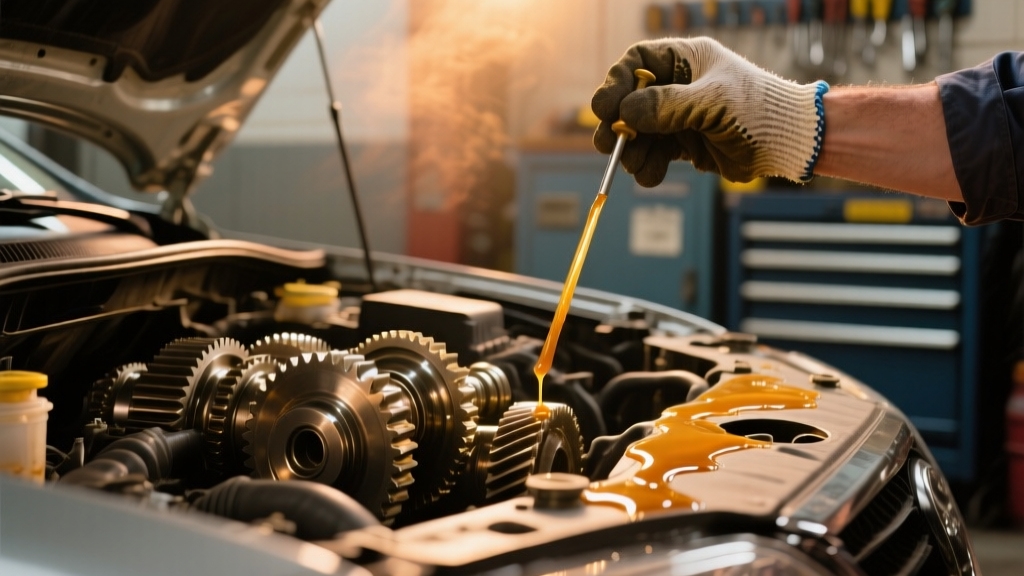Physical Address
304 North Cardinal St.
Dorchester Center, MA 02124
Physical Address
304 North Cardinal St.
Dorchester Center, MA 02124

Transmission fluid typically runs between 170°F and 225°F during normal driving, but can spike above 240°F under heavy loads like towing or aggressive driving.
At these elevated temperatures, fluid additives degrade rapidly, reducing lubrication and increasing wear risk. If fluid surpasses 260°F, severe damage like clutch burnout can occur.
You’ll want to comprehend what influences these temperature changes and how to monitor and manage your transmission’s heat to guarantee long-term performance and reliability.

Although transmission fluid temperature varies by vehicle and conditions, you can generally expect it to operate between 170°F and 225°F during normal driving. Maintaining proper fluid temperature is essential, as using high-quality motor oils like Mobil 1 can indirectly support transmission health by protecting engine components.
This range aligns closely with typical engine temperatures, often around 195°F, ensuring ideal fluid viscosity and performance. Some vehicles, such as certain Toyota models, may exhibit slightly lower operating temperatures near 158-176°F.
While upper limits can reach 220-240°F safely under specific conditions, sustained temperatures above 240°F risk accelerating fluid degradation and damaging transmission components. Temperatures above 240°F can cause varnish buildup and slipping, leading to potential transmission failure.
Monitoring this range is critical because exceeding the ideal temperature window impacts fluid longevity and transmission efficiency.
Understanding this typical range helps you maintain your vehicle’s transmission health by preventing overheating and ensuring consistent, reliable operation.
Because multiple factors directly affect how transmission fluid temperature fluctuates, understanding these influences helps you manage and maintain ideal operating conditions.
Key elements include fluid condition, environmental factors, vehicle load, and transmission design. Each plays a critical role in heat generation and dissipation.
Fluid condition, environment, vehicle load, and transmission design critically influence heat generation and temperature control.
Monitoring these factors allows you to optimize fluid temperature, preserving transmission performance and longevity. Using a compatible OBD2 scanner to monitor transmission temperature can provide early warnings and prevent costly damage.
When you subject your vehicle to heavy loads, stop-and-go traffic, or aggressive driving, transmission fluid temperatures rise sharply due to increased mechanical stress and fluid shear.
Heavy towing intensifies torque converter workload, pushing fluid temperatures near or above 225°F (107°C), risking overheating and vent fluid expulsion. Installing auxiliary transmission coolers can help manage these elevated temperatures during towing.
Continuous stop-and-go driving limits fluid cooling, causing repeated heat spikes that accelerate fluid degradation.
Idling in drive further raises temperatures, especially in hot weather, while shifting into neutral or park reduces thermal buildup.
Aggressive driving, with rapid acceleration and braking, causes erratic temperature fluctuations and viscosity loss, increasing clutch slippage risk.
These conditions demand more frequent fluid maintenance to preserve transmission integrity.
Proper functioning of the transmission system is essential to manage these temperature changes and ensure safe and efficient vehicle operation, highlighting the importance of transmission system performance.
Understanding how diverse driving scenarios elevate fluid heat helps you mitigate wear and optimize transmission longevity.
It’s really important to keep a close eye on transmission fluid temperatures. You see, additives in the fluid start to break down when temperatures hit around 240°F. This is a big deal because when these additives degrade, the fluid can’t do its job of protecting and lubricating the internal components as well as it should.
Overheating can cause varnish formation inside the transmission, further compromising performance. So, why does this matter? Well, if the additives are compromised, it can lead to accelerated wear and even cause premature transmission failure.
Proper gear oil selection and maintenance help prevent such issues by ensuring the fluid performs optimally under stress. Understanding these temperature thresholds is key to keeping everything running smoothly. Don’t overlook it!
Although transmission fluids are engineered to endure high temperatures, their additives begin to degrade considerably once temperatures exceed approximately 175°F (80°C).
This degradation compromises the fluid’s protective properties, such as anti-wear and oxidation inhibition. You should be aware that additive breakdown accelerates with rising temperatures and prolonged exposure.
Additive degradation rate roughly doubles for every 18°F (10°C) increase above 175°F (80°C).
Dexron-VI ATF additives start breaking down near 270°F (130°C).
High-temperature driving conditions, like towing, intensify additive deterioration.
Degraded additives reduce thermal stability, viscosity control, and corrosion protection effectiveness.
Advanced additive packages in motor oils, such as those found in Castrol Edge Extended Performance, demonstrate enhanced protection by forming a protective barrier to reduce friction and wear under extreme conditions.
Monitoring and managing operating temperatures is critical to preserving additive function and extending transmission fluid life. Maintaining optimal flow rates helps ensure even temperature distribution and limits localized overheating.
Since transmission fluid performance hinges on maintaining specific temperature thresholds, exceeding these limits accelerates additive breakdown and impairs protective functions.
You need to keep fluid temperatures ideally under 190°F to preserve viscosity and additive integrity. Operating above 225°F speeds up thermal degradation, reducing lubricity and increasing friction.
When temperatures reach 240°F or higher, varnish deposits form on critical components, causing shifting issues and clutch slippage. Beyond 260°F, fluid films deteriorate rapidly, triggering seal hardening, leakage, and clutch burnout. Modern transmission cooling systems are designed to maintain temperatures typically between 195-210°F to prevent such damage.
Reduced viscosity from heat compromises hydrodynamic lubrication, leading to metal-to-metal contact and accelerated wear. Synthetic fluids tolerate heat better but still face damage above 260°F. Additionally, the choice of fluid additives plays a crucial role in how well the transmission fluid withstands heat and maintains its protective qualities.
Monitoring fluid temperature closely guarantees you prevent irreversible breakdown, maintain transmission efficiency, and extend component lifespan by avoiding excessive thermal stress and additive depletion.
When transmission fluid temperatures exceed the ideal range, they accelerate fluid breakdown and damage critical components. Heat degrades additives, hardens seals, and causes clutch slipping, which compromises lubrication and cooling.
This leads to accelerated wear and potential failure. Proper cooling is essential to prevent fluid degradation and maintain transmission health, especially under heavy loads or towing conditions where heat production is higher.
Automatic Transmission Fluid (ATF) coolers specifically help manage these temperatures effectively. Monitoring fluid condition regularly is important to detect early signs of degradation and prevent damage.
Specifically, you face these consequences:
Sustained high temperatures also increase the risk of leaks and contamination, further compromising transmission reliability and markedly shortening its service life. Regular checks and maintenance of fluid levels and condition are critical to avoid these issues and ensure long transmission life. Using additives for rejuvenation can help restore fluid performance when degradation is detected.
How can you tell if your transmission fluid is overheating? Key indicators include a distinct burning smell and a transmission warning light on your dashboard.
You may also notice slipping gears or delayed shifting, both signs that overheated fluid has lost its lubricating properties. Additionally, overheating can cause seals to fail, resulting in fluid leaks beneath your vehicle.
Transmission fluid temperature exceeding 175°F to 200°F can significantly reduce its effectiveness and increase wear on components. Regular maintenance helps prevent contaminants that degrade fluid quality, similar to the importance of a brake flush in maintaining fluid integrity.
Performance symptoms such as loss of power, grinding noises, or shaking during acceleration further suggest excessive fluid temperature. Low fluid levels often exacerbate these issues.
Detecting these signs early is critical, as overheating typically occurs above 200°F due to factors like overloading, faulty coolers, or incorrect fluid types. Monitoring these symptoms helps prevent severe transmission damage and maintains ideal vehicle operation.
Although transmission fluid temperature isn’t always visible, you can monitor it effectively using several methods, each offering varying levels of precision and real-time feedback. You can rely on:
Transmission fluid temperature isn’t always visible but can be effectively monitored through various precise methods.
Using these methods, you gain precise insights into fluid temperature, helping you avoid overheating and extend transmission life.
To prevent transmission fluid from overheating, you must prioritize regular maintenance and closely monitor fluid condition and levels. Change fluid every 30,000 to 60,000 miles using manufacturer-specified synthetic fluids to enhance heat resistance and reduce friction.
Regularly inspect fluid levels to avoid low-fluid conditions that cause overheating. Maintain the transmission cooling system by cleaning coolers and lines, checking for leaks or blockages, and considering auxiliary coolers for heavy towing or hot climates.
Adjust driving habits by avoiding overloading, using overdrive or tow modes, and shifting gears appropriately to minimize strain and heat buildup. Promptly repair transmission components and seals to prevent fluid loss and mechanical heat generation.
Employ temperature monitoring to detect early signs of overheating and act proactively to sustain transmission efficiency and longevity. Additionally, the use of advanced lubrication oils and fuel additives can enhance engine performance and reduce emissions, indirectly benefiting transmission operation.
Yes, aftermarket transmission coolers can extend your fluid’s lifespan by lowering operating temperatures, especially under heavy loads or towing.
By maintaining fluid closer to 175–195°F, they preserve additive effectiveness and ideal viscosity. This reduces thermal breakdown and varnish formation.
This cooling effect delays seal hardening, clutch slippage, and contamination buildup. Ultimately, it prevents premature transmission failure.
Proper sizing and installation ensure maximum efficiency, minimizing maintenance frequency and costly repairs.
You should know synthetic transmission fluids can withstand temperatures over 250°F, maintaining viscosity and preventing breakdown.
This heat tolerance outperforms conventional fluids, which thin and vaporize sooner, compromising hydraulic function.
The fluid type directly impacts thermal stability; for example, Type F excels in high-stress heat resistance, while Dexron blends suit moderate temperatures.
Choosing the right ATF guarantees maximum lubrication, reduces wear, and extends transmission life under extreme thermal conditions.
You should check transmission fluid levels monthly and change the fluid every 30,000 to 60,000 miles, depending on your vehicle’s specifications.
Regularly inspect and replace transmission filters at recommended intervals to guarantee proper fluid flow.
If you tow heavily or drive in hot climates, consider more frequent fluid changes and install an aftermarket cooler.
Maintaining heat shields and avoiding prolonged idling also help prevent overheating effectively.
Yes, synthetic fluid resists high temperatures better than conventional fluid.
It maintains stability and viscosity at elevated temperatures, delaying thermal breakdown beyond 240°F (116°C).
You’ll benefit from reduced varnish formation, sustained additive effectiveness, and less seal hardening.
However, even synthetic fluids have limits near 270°F (132°C), so monitoring and proper cooling remain vital to prevent transmission damage under extreme heat conditions.
Yes, software updates can influence transmission temperature control by optimizing shift timing and torque converter lockup. This reduces heat generation.
You’ll benefit from refined control algorithms that proactively manage cooling systems and adjust fan or pump speeds based on real-time temperature data.
These updates prevent prolonged high-temperature operation, protecting fluid integrity and components. Consequently, this enhances thermal management efficiency and prolongs transmission life under various driving conditions.
You need to keep a sharp eye on your transmission fluid temperature to avoid costly damage. Modern fluids typically operate between 175°F and 225°F, but overheating beyond 250°F can degrade additives and cause failures.
Just like a knight wouldn’t charge into battle without armor, you shouldn’t drive without monitoring fluid heat. Use sensors and adopt cooling strategies to maintain ideal temperatures, ensuring your transmission performs reliably and lasts longer under varying driving conditions.